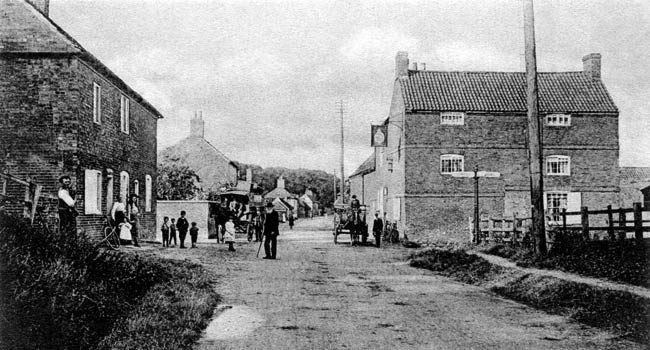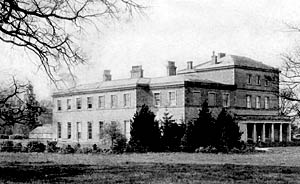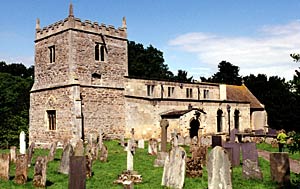< Previous | Contents | Next >
Red Gutter and Deadman 's Field

East Stoke, c.1910.
EAST STOKE. Its red-roofed houses gather pleasantly round the cross-roads on the Fosse Way, and its meadows are by pretty reaches of the Trent. Only a name or two remind us of a black page of history written here four and a half centuries ago, when six or seven thousand men were slain. In 1486 Henry the Seventh had made his throne more secure by marrying Elizabeth of York, so ending the long struggle of the Yorkists and Lancastrians; but there was still unrest among the White Rose supporters, and a priest named Richard Simon planned to set up Lambert Simnel, son of an Oxford joiner, as the young Earl of Warwick, who, like the Earl of Lincoln, was a claimant to the throne. Simon hoped that if the plan succeeded he might become Archbishop of Canterbury.
Simnel was crowned king in Dublin, and an army of Irishmen with 1500 Germans invaded England and went to York. Led by the Earl of Lincoln and Viscount Lovell, they marched south and forded the Trent at Fiskerton to East Stoke, on their way to take Newark. But at East Stoke they were met by the king's army marching out from Nottingham, and for three hours there was stubbornly fought here one of the most terrible conflicts known till then, ending in the complete rout of the Yorkists and the shattering of their hopes for ever.
The fight probably took place about the cross-roads, and the rebels were driven to the steep track running down to the river meadows, still called the Red Gutter. Near the Fosse Way is Deadman's Field, where many of the bodies were buried.

Stoke Hall, c.1910.

East Stoke church in 2001.
Stoke Hall stands back from the river, in a thickly wooded park with lofty beech, elm, and chestnut trees, and the biggest heronry in the county. A magnificent cedar on the lawn is seen from the churchyard wall. The house was bought in the middle of the 18th century by Abel Smith the banker, and until recently was a home of his descendants, the Bromleys and the Pauncefotes whom we meet in the church.
Restoration and rebuilding have spared a little old work in the church, which stands by the lovely lane going to Fiskerton Ferry, passing on its way a grassy track to the meadows where the Red Gutter comes down. Great trees in the churchyard tower above the marshland, and all there is here to remind us of the old struggle are the stones in the porch which are said to have been hollowed out by soldiers sharpening their swords on them. From the close of the 14th century come the west window of the low tower and its arch on 13th century shafts, and the east window. There are fragments of old glass, a medieval piscina, and a chest 500 years old.
We found a framed copy of some extracts from Captain Scott's last message to the nation hanging here, and learned that Scott's friend Admiral Bromley gave it to the church when he left the Hall.
A story belongs to a great Union Jack hanging near the tower. It once floated over our Embassy in Washington, and when Lord Pauncefote, the first British Ambassador to the United States, died there in 1902 the flag covered the coffin in which he was brought home to sleep in this quiet churchyard. The flag is treasured in the church, and a beautiful bronze angel keeps watch over the Ambassador's grave.
The First British Ambassador to America
LORD PAUNCEFOTE was one of the illustrious peacemakers of last century, and he will go down in the annals of the English-speaking peoples as a statesman who brought together in friendship two peoples who were drifting into enmity. He will live also as a pioneer of world peace, for he represented his country at the first Hague Conference, where his wise counsel did much to establish the Permanent Court of Arbitration.
Born at Munich in 1828, he became a lawyer. Having proved his ability as Attorney-General at Hong Kong and as Chief Justice of the Leeward Islands, he was given posts in the Government at home until 1889, when a serious crisis arose with America, our minister there having been dismissed for interfering in a Presidential election. Pauncefote took his place, won back all the confidence that had been lost, and was raised to the rank of ambassador. It is difficult to realise now that at the time he was appointed there were no foreign representatives of Ambassador rank in the United States.
Two serious disputes between the two countries occurred while he was at Washington, but both were referred to tribunals of arbitration, and both parties accepted the awards. The first dispute concerned an American claim to prevent Canadian vessels fishing in the Behring Sea, and the second concerned the boundary between Venezuela and British Guiana. The boundary question needed very tactful handling, for President Cleveland had intervened in a challenging message to Congress which tactlessly invoked the Monroe Doctrine against the very country which had suggested it for the safeguarding of American security. Intense feeling was aroused on both sides of the Atlantic, and for a short time there were shadows of war, but wisdom prevailed and the British claim was upheld.
When Lord Pauncefote died his body was sent home in an American warship, for he had then become widely popular. He had achieved three distinctions of which any man might be proud. He had been the first British Ambassador to America. He had steered us safely through the most war-menacing crisis between the two countries for a generation and more. He had brought the two countries together in the greatest arbitration treaty ever agreed upon, pledging them never to fight one another again.
The Battle of Nobles and Noodles
IN all our annals there is nothing stranger than the story which reached its fantastic conclusion here, the aftermath of the Wars of the Roses. Seldom has there been a more stubborn battle on English soil, never a stranger cause, never a more enigmatic squire than the leader of the defeated army, John de la Pole, Earl of Lincoln.
Head of a great house which in a century had risen from a family of Hull merchants to alliance with royalty, John de la Pole was the grandson of Alice Chaucer, Duchess of Suffolk, and Alice was the granddaughter of Geoffrey Chaucer. Her son married the Princess Elizabeth, a sister of Edward the Fourth. Their son, created Earl of Lincoln by his uncle, King Edward, was adopted by his other uncle, Richard the Third, as heir to the throne of England. He is the towering figure on this battlefield of Stoke.
It was as Heir Apparent, and one of the greatest forces in the realm, that Lincoln entered Bosworth Field, to see Richard slain, and himself dispossessed of all his hopes by the birth at Bosworth of the Tudor dynasty; he left that field dependent for his life on the clemency of the new King, Henry the Seventh. Lincoln took the oath of fealty to Henry and was spared; but, ambition smouldering, he struck, two years later, here at little Stoke, for a kingdom, under the most fantastic banner that ever led nobles and noodles to death. Aiming at the throne, Lincoln used the son of a joiner as a stalking horse. Lambert Simnel was made to personate, first the murdered little Duke of York, and then the Earl of Warwick whom he resembled. Visiting Brabant, Lincoln raised a force of 1500 mercenaries and took them to Ireland. There he arranged for Simnel to be crowned King of England, and with an army reinforced by some 5000 Irish he crossed to the Lancashire coast, landed at Furness, passed through Yorkshire into Nottinghamshire, and here at East Stoke on a blazing summer afternoon encountered the army of Henry.
During the ferocious fighting the aristocratic fellow-conspirators were cut to pieces, save perhaps Viscount Lovell whose fate has nener been known for certain. Some say he was drowned in the Trent; others that he escaped to his home at Minster Lovell in Oxfordshire and died there in a vault where he hid. The priest was flung into a dungeon and never heard of again, and Simnel was derisively exhibited as a scullion in the king's kitchen. Lincoln, the proudest noble in England, was left to moulder into the soil of East Stoke, dead ignobly, fighting under the flag of a tutored Jackanapes whom he had intended to supplant as king.
